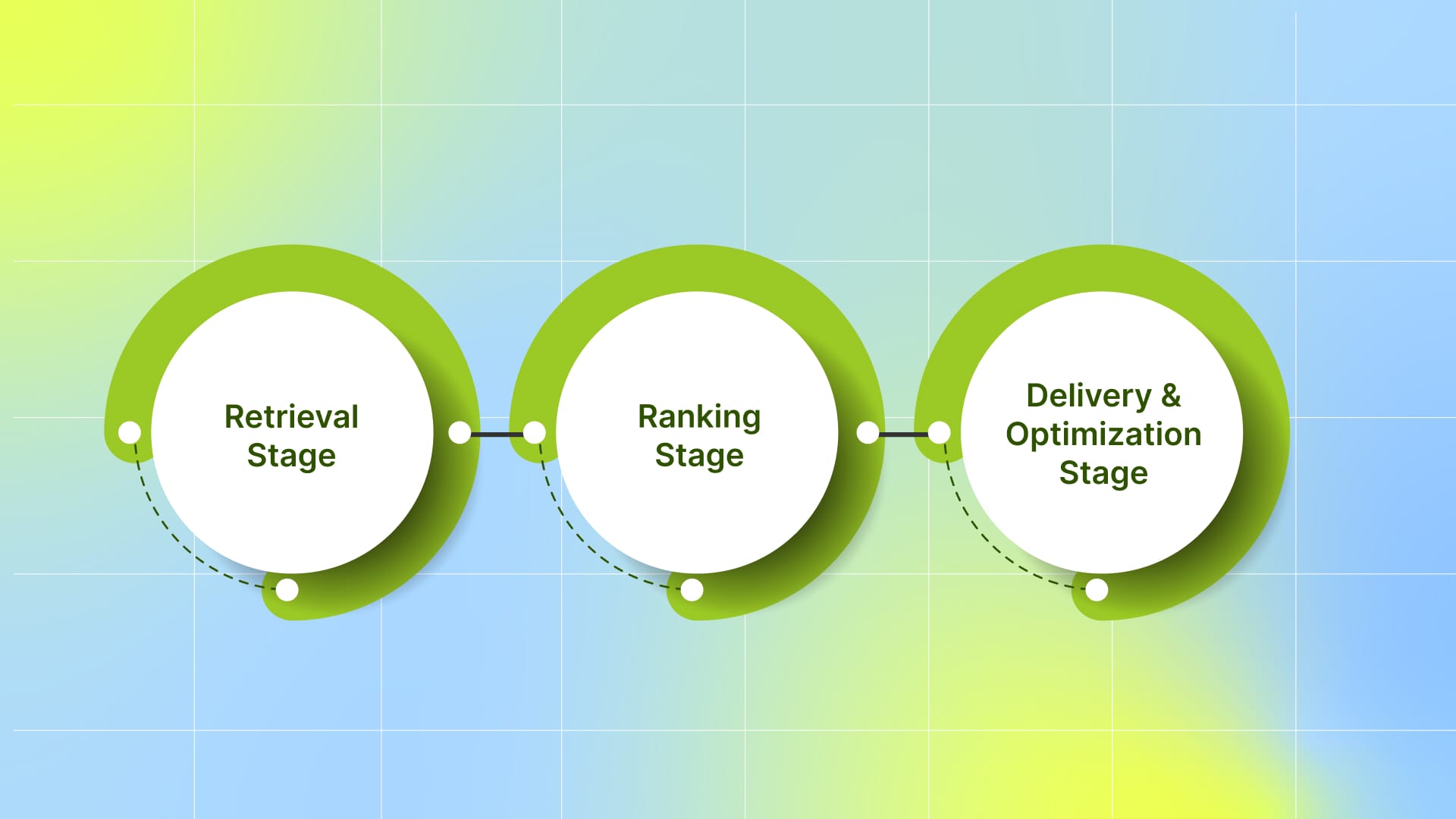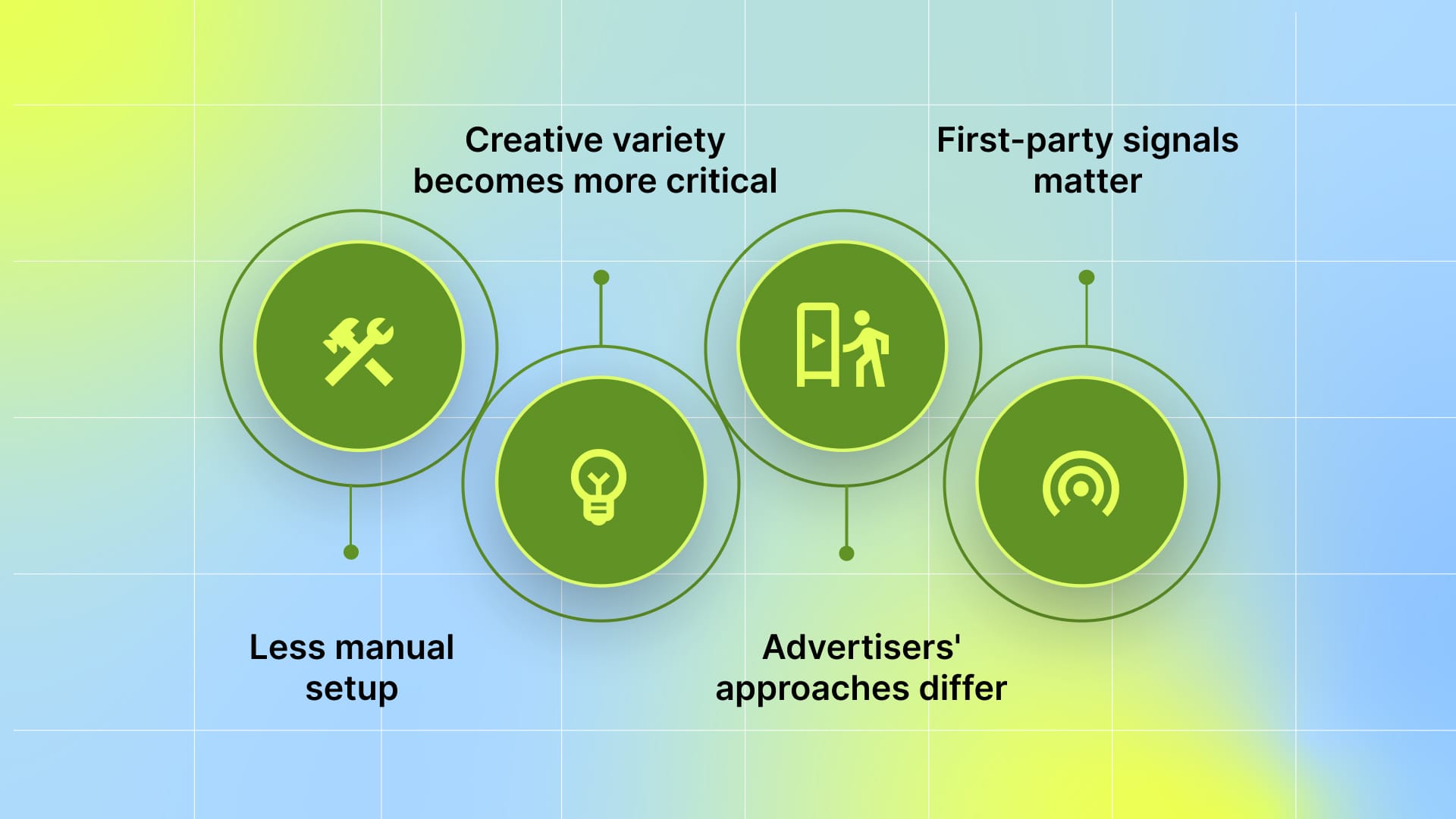Understanding Meta Andromeda for Next-Gen Ad Strategies
Your ad creative often doesn’t even get to prove itself. Before it has a chance to reach your audience, Meta’s system has already filtered it out. The platform now screens a massive pool of ads from the outset, narrowing millions of possible creatives down to a small set of candidates before the auction even begins.
That early filter changes what wins. Near-duplicate or minimally differentiated creatives are less likely to consistently survive retrieval. With Advantage+ automation and generative creative tools multiplying eligible variants, plain repeats and tiny tweaks quickly lose visibility. Splitting budgets across many tiny audience segments spreads learning thin and can hide true performers.
That means repetitive creatives, minimal copy changes, or missing server-side events limit how the system learns and delivers. You may see slow optimization or inconsistent results, not because your creative idea or message is weak, but because the inputs don’t match how Meta Andromeda evaluates ads in 2025.
Meta reports Andromeda’s deployment achieved +6% retrieval recall and +8% ad-quality improvements on selected segments. Advertisers enabling Advantage+ creative saw ~22% ROAS lift, and image generation drove ~7% more conversions.
In this blog, we'll explain how Meta Andromeda works across retrieval, ranking, and delivery, how it ties into Advantage+ automation, and what you can do to align your creative strategy, campaign structure, and data signals for stronger results in 2025.
What is Meta Andromeda?
Meta Andromeda is Meta’s personalized ads retrieval engine that narrows tens of millions of eligible ads to a few thousand candidates per impression, before ranking/auction. Think of it as a fast, intelligent filter: from millions of possible ads, it quickly narrows down a smaller pool to be scored and shown.
Meta created Andromeda because the sheer volume and variety of ads had grown so large that the older system couldn’t manage them efficiently. This new setup allows Meta to use larger models and specialized hardware to match more relevant ads to each person.
Why Did This Update Happen?
If you’ve noticed a wider mix of ad variations from AI-generated visuals to multiple headlines and creative tests, that’s part of the shift driving Andromeda’s rollout. The older ad delivery system was struggling to keep up with this growth, which slowed down decisions and reduced accuracy. Meta needed a way to scan far more ad options for each user in milliseconds while maintaining precision.
Andromeda was created specifically for that purpose. It scales efficiently, works seamlessly with Meta’s Advantage+ automation and generative ad tools, and can evaluate a much larger range of creative options. Over time, it learns which ad versions perform best for each user, helping the platform deliver more relevant and effective advertising experiences.
How Does Andromeda Work?
Here’s a simple breakdown of the three stages that guide how Andromeda selects and delivers ads:

1. Retrieval stage
This new stage matters most for advertisers and creative teams. Andromeda quickly scans the full set of available ads and picks a smaller group of candidates for each person. That pool might drop from millions to a few thousand candidates. This pre-selection happens before the detailed scoring, and it decides which creative even gets a chance to compete. Meta designed this stage to run large models and index ads efficiently
What this means for you: if your creative looks too similar to many others, it can be filtered out early. A diverse creative that connects to different signals is more likely to pass the retrieval filter.
2. Ranking stage
After retrieval, the system scores and ranks those candidate ads for a particular person. This stage uses models that predict how likely a given person is to take an action (click, install, purchase). The ranked list reflects both predicted value and bid strategy. Since Andromeda enhances the quality of the retrieval pool, the ranking stage begins with improved options, enabling the delivery of higher-value ads more frequently.
What this means for you: you’ll see the platform favor ad versions that drive the right outcomes, not just high engagement. That makes the creative-to-conversion path more important.
3. Delivery and optimization stage
The top-ranked ad enters delivery. Here, the usual optimizations run: placement choices, pacing, and conversion tracking. Andromeda’s improvements upstream help this stage by giving it stronger candidates to pick from. Over time, the system learns which creatives work for which users and shifts delivery accordingly. This loop of retrieve, rank, and deliver is how the system repeatedly improves performance on real campaigns.
What this means for you:testing many distinct creative ideas and letting the system learn will often outperform many tiny tweaks to a single creative.
All these stages depend on serious engineering muscle under the hood. Here’s what makes that performance possible.
Meet the Tech Behind Andromeda
Meta built Andromeda as an integrated package of hardware, software, and models. Key points to know:
Meta uses specialized chips and infrastructure to run much larger models in real time. The system was designed to run on NVIDIA Grace Hopper Superchips and Meta Training and Inference Accelerator (MTIA) to handle huge compute needs.
The retrieval architecture uses hierarchical indexing and deep neural networks so that it can search massive ad catalogs quickly. This lets the platform consider far more ad variations than before.
Meta reported measurable early gains from the change. Examples include improved retrieval recall and higher ad quality across selected segments, driven by the larger models and new indexing approach.
As Meta Andromeda continues to reshape how ads are matched and delivered, the key is to stay flexible, let data guide your creative choices, and allow the system to learn what truly connects.
Now that you know what powers Andromeda, let’s see how it connects with Meta’s automation tools to simplify campaign setup and delivery.
How Andromeda Connects With Advantage+ and Meta Automation
Think of Andromeda as the new brain that helps Meta pick which ad to show, and Advantage+ as the set of rules that lets that brain act fast for you. Andromeda operates at the retrieval stage, scanning vast sets of ads and potential viewers to identify the best matches in real time. That change shifts much of the hard work from manual audience lists and manual bid adjustments to the system itself.
How the Connection Works
Andromeda powers the retrieval step: it narrows millions of ad-and-user possibilities into a short list before ranking and showing an ad. That makes delivery more precise and efficient.
Advantage+ is a product surface that benefits from Andromeda’s retrieval improvements, such as automation of targeting, budget, and placements. While you don’t need Advantage+ to assist, its features enhance the overall effect. Therefore, when you select Advantage+ options, you’re giving Andromeda the rules and data it requires to act.
The system runs on newer hardware and models to speed up those decisions. That lets the platform personalize at scale without slowing delivery.
Because the retrieval engine now personalizes earlier in the delivery chain, simple campaign setups often outperform highly segmented ones. You’ll likely see better returns when you let the system test many creative-and-audience combinations, rather than creating lots of tiny audience groups. That’s why many advertisers are moving to fewer campaigns with broader settings and many creative variations.
How to Make the Most of It
Focus on creative variety. Upload a variety of short videos, headlines, and images to help the system match different users.
Use broad targeting with smart exclusions, consolidated structure, and CAPI + Pixel with event_id dedup to feed high-match signals.
Consolidate campaign structure: fewer campaigns, fewer ad sets, more creative assets. That gives the system richer data per learning loop.
Set clear conversion signals and conversion windows. The engine optimizes based on the signals you provide, so choose the event that directly ties to business value.
Add smart exclusions when you need to avoid specific groups (such as recent buyers). Exclusions let you guard outcomes while still using broad delivery.
What to Watch For
Because the engine personalizes so early, single creative winners are rarer. A creative that works for one person may not work for another. Track performance by cohort and by creative mix rather than chasing one perfect ad. Also, watch pacing and early learning: give the system enough budget and time to test variations.
Andromeda is the retrieval engine that makes Advantage+ automation smarter and faster. If you let the platform run more of the delivery and feed it strong, creative, and clean conversion signals, you’ll get more usable learning and a simpler workflow.
Also Read: Enhancing Creative Campaigns with AI: Top Strategies for Performance Marketing
Why This Matters for Performance Marketers
Ad setups keep getting longer, data keeps shifting, and it’s harder to tell what’s actually working. That’s where Meta’s new system, Andromeda, starts to make a difference:

Less manual setup and faster matching: You no longer need to build tiny, hand-crafted audience lists to get started. Andromeda looks across large pools of creative and signals, then finds candidate ads in milliseconds. That means less time spent on manual audience targeting and more time on what moves results.
Creative variety becomes more critical: Because the system tests many creative options against different people, a wider mix of headlines, visuals, and hooks raises your odds of finding the right match. Simple repeats or small tweaks aren’t enough; diverse ideas give the engine more to work with.
Small and large advertisers can both benefit, but your approach should differ: If you have a big budget and many assets, the system will explore broadly and scale winners quickly. If you’re smaller, focus on a compact set of high-quality creatives and clear conversion goals so the engine can learn fast without wasting spend. The mechanics are the same, but how you organize assets and budgets matters.
First-party signals and catalog quality matter more for some campaign types: For campaigns that aim at purchases or in-app events, clean first-party conversion data and well-organized product catalogs help the system learn who to show your ads to. Better signals lead to better retrieval choices and stronger return on ad spend.
Andromeda shifts performance marketing from heavy setup work to smarter system learning. Success now depends on providing strong creative variety, clear goals, and quality data so the model can identify and scale what drives real results.
To turn those insights into stronger outcomes, here are some best practices you can apply right away.
Also Read: Understanding Mobile App Attribution
Best Practices to Make the Most of Meta Andromeda
Andromeda selects ads for users differently. Make targeted adjustments so the system aligns with your goals. Follow these best practices to help Andromeda understand your campaign priorities and respond faster.
1. Keep Your Campaign Setup Simple
What to do:
Run one campaign per conversion objective (purchase, install, lead). Inside it, keep one primary ad set that holds your candidate creatives. Use a small, separate test campaign to experiment with structure or radically different funnels. Ensure enough daily budget to reach statistically useful learnings per creative (~50 events/week, objective-dependent).
Why this converts: fragmentation spreads budget and reduces the chance your best asset reaches the right users in Andromeda’s candidate pool.
2. Creative Strategy That Wins
What to do:
Upload 8–12 distinct conversion creatives per ad set. Each should differ in hook, format, and offer (e.g., short UGC 6 - 15s, 15 - 30s demo, testimonial, static with clear pricing).
Lead with a measurable outcome (discount %, trial length, exact time-to-onboard). Use one clear CTA tied to the tracked conversion event.
Why this converts: the retrieval stage favors clearly different candidates. Small cosmetic edits rarely win; you need different reasons for a user to act.
Pro tip: Tag the key creative parts: hook, format, offer, CTA, hero, runtime, thumbnail, and audience. This makes every asset searchable, comparable, and linked to measurable results, so you can quickly see which elements drive performance instead of guessing.
Segwise uses AI-assisted creative tagging to identify and organize these elements across your creatives, then maps them to performance data from ad networks and MMPs, surfacing tag-level CTR, IPM, and ROAS in one clear dashboard.
3. Event and Data Hygiene
What to do:
- Implement Conversions API (server-side) alongside the Pixel and deduplicate with event_id. Send purchase value, currency, and order_id. Verify green status in Events Manager.
- If possible, send first-month revenue or cohort LTV back as a parameter for higher-fidelity value signals.
Why this converts: Andromeda and Meta’s value optimizers depend on accurate, high-match rate signals to prioritize higher-value users. Without server events and value, the system optimizes to weaker proxies.
4. Bid Strategy for Revenue and Retention
What to do:
When you can reliably send value, run value-maximizing bids (maximize purchase value) rather than raw volume.
If you must control CPA, start with a cost-cap set conservatively and loosen as you learn. Avoid heavy bid-capping early, as it can restrict the model from finding higher-value users.
Avoid tight cost caps during early exploration; widen caps or switch to lowest-cost until you identify viable cohorts, then re-introduce cost control.
Why this converts: optimizing for value steers spend toward users who bring more revenue and better long-term return, instead of cheap, low-value conversions.
5. Protect Conversion Quality
What to do:
Run incrementality tests (holdout or lift studies) before full-scale budget increases. Use Meta Experiments or a parallel holdout design to measure true causal lift.
Monitor downstream KPIs (30/60/90-day retention, repeat purchase rate, AOV) and use them as gating metrics for scale.
Run lift tests quarterly or before major budget increases/creative overhauls.
Why this converts: volume without quality destroys margins over time. Incrementality confirms whether on-platform conversions produce real business value.
6. Strengthen App Tracking (For Mobile Teams)
What to do:
For iOS, configure SKAdNetwork with a sensible conversion-value mapping (focus on meaningful in-app milestones). Expect coarse, delayed postbacks and design windows around that reality.
Use your MMP and server data together to reconcile attribution and to feed value back into Meta. If your MMP supports Advanced Mobile Measurement, coordinate to obtain the richest, most usable rows for analysis.
Map few, high-signal milestones into your 64-value schema; don’t over-granularize.
Why this converts: iOS aggregation changes how value signals arrive, pairing SKAN with server-side signals keeps your optimization grounded.
7. Refresh Ads With Purpose
What to do:
Keep a high-performing conversion creative live for at least 7–14 days (longer if volume is low). Rotate in new, truly different hooks every 10–21 days based on decay and performance.
Avoid frequent cosmetic edits; instead, produce modular variants (different hook, proof, or offer). Tag assets with hook, offer, and launch date so performance maps cleanly.
Rotate 2–3 new distinct hooks per cycle; retire under-performers only after sufficient impressions and stable CPAs.
Why this converts: Andromeda needs stable signals to learn, but also benefits when candidate pools include clearly new candidates. Balance stability and novelty.
Focus on strong signals, clear creative variety, and real conversion value. Meta Andromeda rewards advertisers who simplify structure, feed it clean data, and pair automation with thoughtful creative strategy.
Also Read: Creative Tagging Tools That Can Boost Your Ad Campaign ROI in 2025
Conclusion
Meta describes Andromeda as a retrieval layer that filters candidate ads early in the delivery chain using advanced hardware and custom accelerators. This setup prioritizes clear conversion signals, diverse creative assets, and simple campaign structures that provide the system with enough data to learn effectively.
To get the best results, send reliable server-side events through the Pixel and Conversions API with matching event IDs, test distinctly different creatives, and avoid fragmented ad sets. Keep in mind that retrieval is not the final auction. Andromeda narrows down the options, but ranking and auction models still decide which ad is shown. Results also vary by advertizer, so it’s smart to validate changes with holdout or lift tests before scaling.
As advertisers adapt to this new model, the challenge isn’t just creating more ads; it’s understanding which creative elements actually drive value. That’s where Segwise fits in naturally. While it doesn’t change how Andromeda works, it helps you prepare and refine creative assets so they perform better within Andromeda’s retrieval system.
Segwise is a creative analytics platform that connects directly to your Meta Ads account, automatically tagging elements like visuals, hooks, and CTAs with AI, and linking them to performance data. This makes it easy to identify which creative combinations drive real results.
Using these insights, you can refresh campaigns with purpose, double down on high-performing ideas, and keep your creative mix aligned with what Meta’s system values most.
Try Segwise with a free trial and make your creative data work smarter.
FAQs
1. How should I structure campaigns to work with Andromeda?
Use simpler setups: one campaign per conversion objective, fewer ad sets, broader targeting with smart exclusions, and many distinct creatives per ad set so retrieval has varied candidates to test.
2. How does the retrieval step differ from ranking?
Retrieval narrows millions of ads to a smaller candidate set per person; ranking then scores those candidates by predicted outcomes to determine order and delivery.
3. Do I need Advantage+ to benefit from Andromeda?
No, Advantage+ makes automation easier, but Andromeda’s retrieval improvements apply across Meta’s delivery system and can help standard campaigns too.
4. What creative types should I prioritize?
Prioritize distinct hooks and formats (short UGC-style clips, demos, testimonials, and offer-led statics) over numerous minor cosmetic edits.
5. How can I test whether Andromeda improves my results?
Run holdout or lift tests and track downstream metrics, such as revenue per user, retention, and average order value, in addition to short-term CPA.

Comments
Your comment has been submitted successfully!